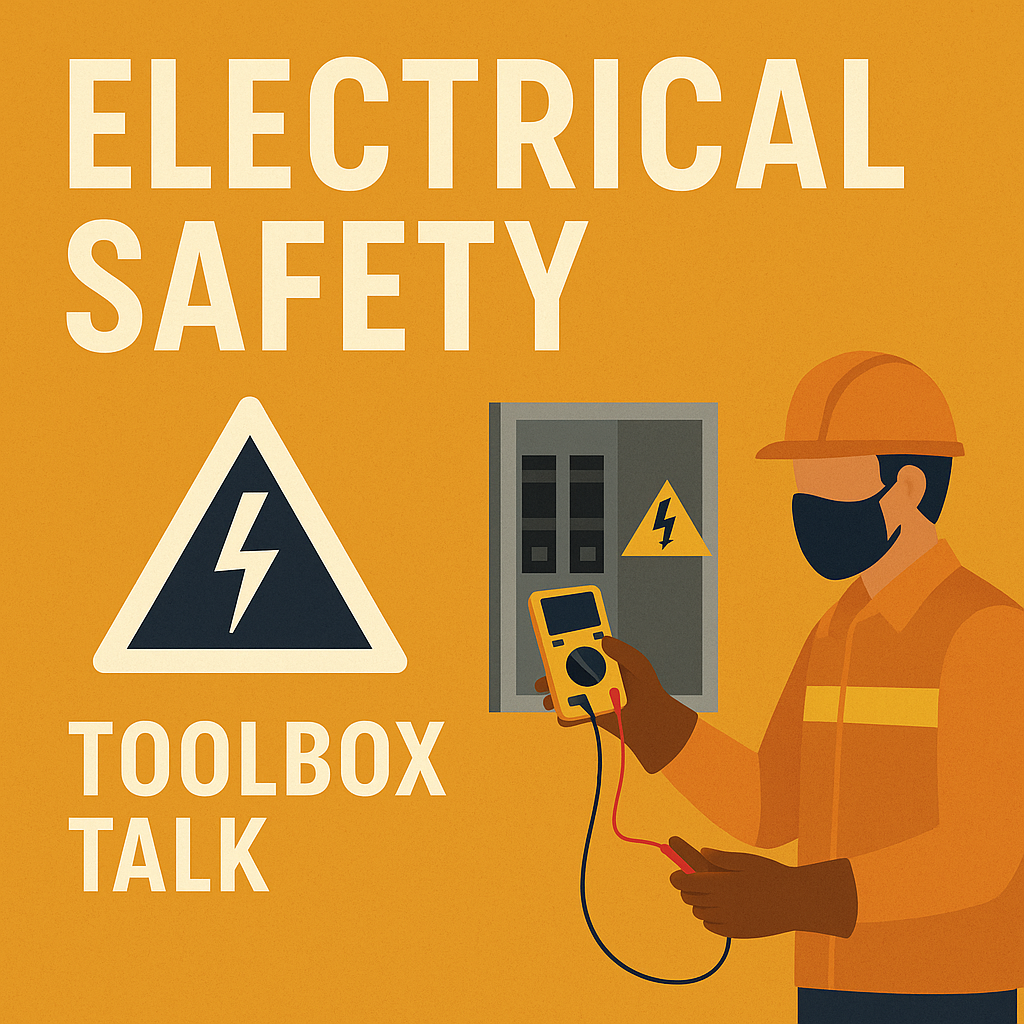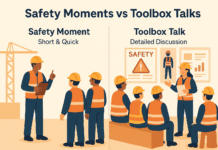
Electrical Safety TBT
Good morning team,
Today’s topic is Electrical Safety — a subject that demands our full attention because electricity doesn’t give second chances.
You can’t see it. You can’t smell it. But one mistake can mean burns, nerve damage, heart failure, or death. Even low voltage can kill under the right conditions. And electricity is everywhere on our site — powering tools, lighting, equipment, and machinery.
So today, we’ll talk about:
- Why electrical safety matters
- The main hazards
- Safe work practices
- Lockout/tagout
- Do’s and don’ts
- Real-life case study
- Closing message
1. Why Electrical Safety Matters
- Electrocution is one of the “Fatal Four” causes of death in construction.
- Most electrical incidents happen because of faulty equipment, poor maintenance, or unsafe work practices.
- Even a small shock can cause you to lose control and fall, leading to secondary injuries.
- Many electrical hazards are hidden — damaged wires under insulation, or circuits you think are dead but aren’t.
2. Hazards of Electricity on Site
2.1 Electric Shock
- Caused by current passing through the body.
- Severity depends on voltage, current, and path through the body.
2.2 Burns
- Electrical burns from contact.
- Arc burns from high-temperature flashes.
2.3 Arc Flash and Arc Blast
- Intense heat and light from an electrical fault.
- Temperatures can reach 35,000°F — hotter than the sun’s surface.
- Blast can cause shrapnel injuries and hearing damage.
2.4 Fire
- Caused by overloaded circuits, faulty wiring, or overheated equipment.
2.5 Explosions
- Electrical sparks in flammable atmospheres.
3. Safe Work Practices
3.1 Always Assume Circuits are Live
- Treat every wire as energized until proven otherwise.
3.2 Inspect Before Use
- Check cords, plugs, and tools for damage.
- Look for frayed wires, exposed conductors, or cracked insulation.
3.3 Use the Right Equipment
- Tools and cords rated for the job.
- Use Ground Fault Circuit Interrupters (GFCIs) in wet or outdoor areas.
3.4 Maintain Safe Distances
- Stay clear of overhead power lines — maintain the required clearance.
- Use non-conductive ladders near electricity.
3.5 Keep Dry
- Never work on electrical equipment in wet conditions without proper protection.
4. Lockout/Tagout (LOTO)
- Before repairing or servicing electrical equipment, isolate the power.
- Use lockout devices and tags to prevent accidental re-energizing.
- Only authorized, trained personnel may perform LOTO.
- Verify isolation before starting work.
5. Personal Protective Equipment (PPE)
- Insulated gloves and tools.
- Flame-resistant clothing for arc flash protection.
- Safety glasses or face shields.
- Hard hat.
- Hearing protection for noisy environments.
6. Do’s and Don’ts
✅ Do:
- Follow permit systems where required.
- Report damaged electrical equipment immediately.
- Use proper cable management to avoid trip hazards.
- Follow manufacturer instructions for tools.
❌ Don’t:
- Bypass fuses or circuit breakers.
- Overload sockets.
- Work on live circuits unless absolutely necessary and authorized.
- Use metal ladders near electrical systems.
7. Step-by-Step Electrical Safety Procedure
- Identify electrical hazards.
- Isolate the source using LOTO.
- Test for absence of voltage.
- Use the correct PPE.
- Maintain a safe working distance.
- Avoid working alone when handling high-voltage equipment.
- Restore power only after all work is complete and equipment is safe.
8. Real-Life Case Study
In 2021, a worker was electrocuted while replacing a light fitting. He believed the circuit was off but hadn’t tested it. The breaker had been mislabeled, and the line was still live.
Lesson: Never trust labels or assumptions — test every circuit before touching it.
9. Worker Engagement – Q&A
- What’s the first thing you should do before working on electrical equipment?
- Why do we use GFCIs?
- What does LOTO stand for and why is it important?
10. Closing Words – Bringing It Back to the Start
Alright team, we began today by saying electricity doesn’t give second chances — and that’s the truth.
Every time you work around electrical systems, remember the basics:
- Inspect before you use.
- Isolate before you touch.
- Test before you trust.
If something feels unsafe, stop and get it checked. A five-minute delay is nothing compared to a lifetime of injury — or worse.
Let’s keep our focus sharp, follow our procedures, and protect ourselves and each other.
Stay alert, stay safe, and let’s have a productive day.
Reporting Near Misses 5 Minute Safety Talk
Heat Stress and Hydration 5 Minute Safety Talk
























